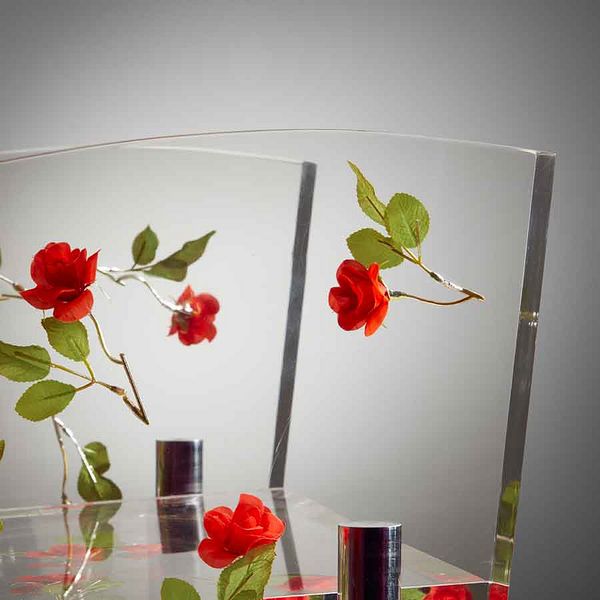Shiro Kuramata, Miss Blanche chair, 1988. Design New York.
Written by Nick Haramis
In his New Yorker review of the original 1947 Broadway staging of A Streetcar Named Desire, Wolcott Gibbs wrote about a “disturbing play, almost faultless in the physical details of its production.” He was describing, of course, the now‐canonical unraveling of Blanche DuBois, by birth a Southern Belle, now a wilting flower of a woman, who arrives on her sister’s doorstep in a rough section of New Orleans clutching pearls she can no longer afford. But Gibbs could just as accurately have been referring to Shiro Kuramata’s Miss Blanche chair, which the Japanese designer was inspired to make in 1988 after watching Elia Kazan’s 1951 film adaptation of Southern Gothic by Tennessee Williams. Like the playwright’s antiheroine, Kuramata’s Miss Blanche is an uneasy study in the performance of perfection. Supported by four tubular anodized aluminum legs rendered in purple, the seat comprises thick, knife‐sharp transparent acrylic slabs containing floating paper roses (not unlike the ones that decorate Blanche’s dress), which were painstakingly positioned using tweezers into four molds as the liquid acrylic cured.
Blanche, wrote Gibbs, “[…] has manufactured a gaudy [… ] substitute past for herself.” In fact, at one point in the film, even she says about a prospective suitor, “He thinks I’m prim and proper. I want to deceive him enough to make him want me.” Hers is a projection of purity that seems to have resonated with Kuramata, who quit experimenting with natural roses when the hot liquid acrylic, itself a glass substitute, burnt one too many real petals. Kuramata’s assistant at the time, Hisae Igarashi, recalls him saying, “It has to be fake, because Blanche Dubois herself is a fake.” Kuramata’s reverence for artifice, however, is genuine; in the chair’s elegant construction, he has made an expressive object that belies its own materiality: its function as a place to sit is beside the point. Like the story that led to its creation — a tale, according to Gibbs, of “dragging something out into the light” — the chair communicates the beauty of seeing something for what it really is, even when it’s not flattering.
Shiro Kuramata, Miss Blanche chair (detail), 1988. Design New York.
In each of his canon‐altering objects, from his white acrylic Ghost lamps to the expanded steel mesh of his How High the Moon armchair, which had neither an interior frame nor support, Kuramata, too, was dragging something out into the light: us. As we interact with his work, we are confronted by the seductive presence of his anti‐gravitational nothingness, or, to paraphrase Milan Kundera, “[…] the unbearable, euphoric lightness of being.” Kuramata debuted Miss Blanche at a KAGU exhibition during Tokyo Designers’ Week in 1988, and again the following year in a solo show of his work at Galerie Yves Gastou in Paris. While his peers, particularly the Italian designer Ettore Sottsass — a friend and collaborator who invited him to join the Memphis collective at its founding in 1981 — were displaying objects whose volume was largely expressed by surface area, he introduced the world to Miss Blanche, a deceptively airy chair that disappears almost entirely so that just a bed of roses seems capable of holding the weight of a human body. It is not just a miracle of technique, although it is that; it is also a celebration of belief. It is a perfectly suspended dream that we can experience with eyes wide open.
Miss Blanche was produced as an edition of 56, one for each year of Kuramata’s life. When he died in 1991, at the height of his career, Miss Blanche, his final piece, took on an elegiac aura. Whereas those flowers once captured the tragic beauty of Blanche DuBois, they have since become symbols of their creator. Someone once said that designing death is the greatest proof of life. It’s hard to think about that without remembering Blanche’s final scene in the film. In a rare moment of resignation amid her crescendo of hysteria, she manages to convince a doctor not to confine her to a straitjacket. Just then, an actual smile — maybe the first we’ve seen from her — stretches across her otherwise woebegone face. It’s as if she’s finally been set free by her own disintegration. And in a way, she has.
Shiro Kuramata, Miss Blanche chair (detail), 1988. Design New York.
Nick Haramis is a New York-based journalist and contributing editor at T: The New York Times Style Magazine. He was formerly the editor-in-chief of Interview.
Recommended Reading
Synthetic Biology: Joris Laarman's "Bone" Chair>
Sound Discoveries: David Moss on Harry Bertoia's "Sonambients"


